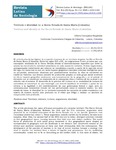Mostrar o rexistro simple do ítem
Territorio e identidad en la Sierra Nevada de Santa Marta (Colombia)
| dc.contributor.author | Carvajalino Slaghekke, Alberto | |
| dc.date.accessioned | 2019-04-11T08:33:32Z | |
| dc.date.available | 2019-04-11T08:33:32Z | |
| dc.date.issued | 2018 | |
| dc.identifier.citation | Revista Latina de Sociología,2018,8(3):94-112.ISSN: 2253-6469 | es_ES |
| dc.identifier.issn | 2253-6469 | |
| dc.identifier.uri | http://hdl.handle.net/2183/22620 | |
| dc.description.abstract | [Resumen] El artículo aborda las lógicas de ocupación humana de un territorio singular: La Sierra Nevada de Santa Marta (Colombia). Entre los siglos XVI a XXI las migraciones fueron atraídas por una concepción idealizada de la Sierra Nevada debido al desconocimiento específico que sobre la misma poseía la sociedad colombiana. Dichas migraciones, protagonizadas inicialmente por colonos, se complejiza, cuando a partir de la segunda mitad del siglo XX a hoy, en dicho espacio geográfico coinciden intereses divergentes para su ocupación, provocando tensiones que posteriormente muchas de ellas se convierten en conflictos violentos. Las formas sociales de producción propias de cada grupo social inmersos en dicho espacio geográfico moldearon una interpretación de la geografía y es el paisaje el elemento que se constituye en contentivo de la concepción ética y estética de los mismos y su relación con el entorno. El desarrollo de la práctica del turismo en su modalidad de turismo de naturaleza se constituyó en una estrategia que intento reordenar el territorio a partir de un retorno a la legalidad y gobernanza, pero su intencionalidad subyacente resulto ser tan perturbadora como el conflicto mismo. En este estado de cosas la identidad de un territorio trasciende las apuestas de orden económico y se inserta de manera mucho más profunda en el ethos que obliga a realizar un ejercicio de comprensión más profundo. | es_ES |
| dc.description.abstract | [Abstract] The article addresses the logics of human occupation of a singular territory: The Sierra Nevada de Santa Marta (Colombia). Between the 16th and the 21st centuries, migrations were attracted by an idealized conception of the Sierra Nevada due to the specific ignorance that Colombian society had about it. These migrations, initially carried out by settlers, become more complex, when from the second half of the 20th century to today, divergent interests coincide in that geographical space, causing tensions that later turn into violent conflicts. The social forms of production of each social group immersed in this geographical space shaped an interpretation of geography and the landscape is the element that constitutes content of the ethical and aesthetic conception of them and their relationship with the environment. The development of the practice of tourism in its type of nature tourism became a strategy that tried to reorder the territory from a return to legality and governance, but its underlying intentionality turned out to be as disturbing as the conflict itself. In this state of affairs, the identity of a territory transcends the bets of economic order and inserts itself in a much deeper way in the ethos that forces us to carry out an exercise of deeper understanding. | es_ES |
| dc.language.iso | spa | es_ES |
| dc.publisher | Universidade da Coruña | es_ES |
| dc.relation.uri | https://doi.org/10.17979/relaso.2018.8.3.3348 | |
| dc.rights | Atribución-CompartirIgual 3.0 España | es_ES |
| dc.rights.uri | http://creativecommons.org/licenses/by-sa/3.0/es/ | * |
| dc.subject | Territorio | es_ES |
| dc.subject | Violencia | es_ES |
| dc.subject | Turismo | es_ES |
| dc.subject | Migraciones | es_ES |
| dc.subject | Identidad | es_ES |
| dc.subject | Territory | es_ES |
| dc.subject | Violence | es_ES |
| dc.subject | Tourism | es_ES |
| dc.subject | Migrations | es_ES |
| dc.subject | Identity | es_ES |
| dc.title | Territorio e identidad en la Sierra Nevada de Santa Marta (Colombia) | es_ES |
| dc.title.alternative | Territory and identity in the Sierra Nevada de Santa Marta (Colombia) | es_ES |
| dc.type | info:eu-repo/semantics/article | es_ES |
| dc.rights.access | info:eu-repo/semantics/openAccess | es_ES |
| UDC.journalTitle | Revista Latina de Sociología | es_ES |
| UDC.volume | 8 | es_ES |
| UDC.issue | 3 | es_ES |
| UDC.startPage | 94 | es_ES |
| UDC.endPage | 112 | es_ES |
| dc.identifier.doi | https://doi.org/10.17979/relaso.2018.8.3.3348 |
Ficheiros no ítem
Este ítem aparece na(s) seguinte(s) colección(s)
-
REV - RLS - Vol. 08, Nº 3 (2018) [12]
Este número contiene un monográfico sobre la diversidad en los países iberoamericanos






